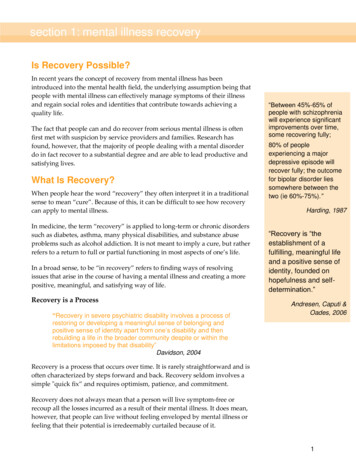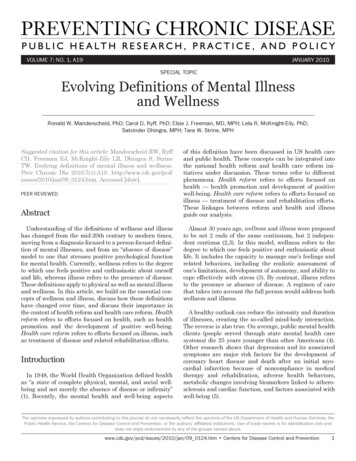
Transcription
Domesticity, Identity and MentalIllness in Jane Eyre and Rebeccafrom a Feminist PerspectiveSteve Mark CowanStudentvt 2017Examensarbete för kandidatexamen, 15 hpEngelska
AbstractThis qualitative essay explores and compares women’s roles and identities in the gothic novelsRebecca and Jane Eyre. The investigation shall be a social critique on feminine ideals from afeminist perspective. Comparable analysis of the “other women” who act as doubles for theprotagonists will be essential to understanding the alter egos of Mrs. de Winter and Jane Eyre. Thesedouble personalities raise questions of identity and the roles of femininity. Similarly the powerstruggles between husband and wives and other feminine influences shall throw further light onprevailing feminine ideals of the times. I shall analyze Daphne du Maurier’s Rebecca in relation tothe concepts of the “Angel in the house” and the “Mad Woman in the Attic” with Charlotte Bronte’snovel to explore parallels between the plot and female characters. I shall show how Daphne duMaurier offers varying feminine models and ultimately takes a feminist standpoint with her novelmuch like Brontë’s Jane Eyre before her. Finally, I will show how the suppression of women bymen through gender stereotyping can lead to female rebellion and, in turn, the stigmatization offemale madness.Keywords: femininity, feminist, gender stereotyping, madness, gothic
Table of contentsIntroduction .5-6To be an Angel or not to be .6-12Alter Egos, the Other Woman and their Husbands.12-17The Stigma of Female Madness and the Fallen Woman .17-23Conclusion . 23Works Cited . 24
IntroductionDaphne du Maurier’s commercial success with Rebecca was largely dependent on thenovel being advertised as a gothic love story where the villainous “other woman” isdefeated and the married couple can live happily ever after. However, I believe DuMaurier’s novel was influenced by Charlotte Brontë’s Jane Eyre in that it is more than alove story and is a covert social critique on gender inequality for women. In the novelsRebecca and Jane Eyre the authors use similar literary devices which aid as socialcommentary on the prescribed roles for women of their day. In Sandra M. Gilbert andSusan Gubar’s famous work The Madwoman in the Attic: The Woman writer and theNineteenth Century Literary Imagination, 1979, they explore the “fallen woman” roleBertha Mason represented in Jane Eyre. However, I believe their study and the madfallen woman concept can also be applied to Du Maurier’s Rebecca were the similardevice of a fallen other woman is used. Rebecca represents the alter ego of Mrs. deWinter and the latter is challenged by this rival. In both novels the rivalry and contrastsbetween the protagonists and the other women shed light on ideals of femininity.Furthermore, Bertha represents female madness and the fallen “angry” woman andRebecca, the fallen “promiscuous” woman.Jane Eyre and Mrs. de Winter must gainknowledge from other characters on negative and positive femininities in order to helpthem avoid being labelled as fallen women themselves.Even though Jane Eyre was written in 1847 and Rebecca in 1938 there aresimilarities in the challenges the protagonists face in the societies they live in. Theirhusbands pose a challenge because of their preconceived female gender roles inmatrimony. Furthermore, the other women, Rebecca and Bertha, not only challenge theprotagonists but also the social norms of their times. The Victorian Coventry Patmore’s“The Angel in the House” shall be examined to demonstrate how Mrs. de Winter fits thedescription of the 19th century ideal of femininity in comparison to the femalecharacters in Jane Eyre. When comparing the characters Jane Eyre and Mrs. de Wintertheir differences and similarities shall shed light on how these women respond to thedomestic expectations and suppression they must face, albeit in different time periods.I shall argue how through their relationships with other feminine models and theirrivalry with the fallen women Bertha and Rebecca, Jane and Mrs. de Winter learn toreject their alter egos to survive their oppressive husbands. I shall show how through5
stigmatizing Bertha and Rebecca as fallen women their former husbands intend totarnish their reputations whilst maintaining their own innocence. Furthermore, my aimis to show how female madness and the fallen woman concept was a stigma created bypowerful men through social conditioning which helped maintain a gender hierarchywhich favoured men.I shall use Gilbert and Gubar’s authoritative 1979 study to explore CoventryPatmore’s concept of the Angel in the House and to explore how the other womenBertha and Rebecca represent the rejection of this feminine ideal. For comparisons onJane Eyre and Rebecca I shall use Miquel Baldellou Marta’s article “Caught up inBetween Doublets: Neo-Victorian (Trans) Positions of Victorian Femininities andMasculinities in Jane Eyre and Rebecca,” 2009. For viewpoints on villainy in RebeccaAuba Llompart Pons’s article “Patriarchal hauntings: re-reading villainy and gender inDaphne du Maurier’s ‘Rebecca,’” 2013, will serve as a starting point for discussion.Finally, from a feminist perspective, I shall analyse these fallen women and the stigmaof female madness from both a fictional and a non-fictional context using studies fromElaine Showalter’s book The Female Malady: Women, Madness and English Culture,1830 – 1980, (1987).To be an Angel or not to beIn Victorian times Coventry Patmore wrote a description of the ideal of femininity inhis poetry which came to represent how a woman should behave due to her perceivedfemale nature. Women were expected to be devoted to their husbands and be submissiveto them as they were fundamentally different than men:The popular Victorian image of the ideal wife/woman came to be “the Angel inthe House”; she was expected to be devoted and submissive to her husband. TheAngel was passive and powerless, meek, charming, graceful, sympathetic, selfsacrificing, pious, and above all–pure. The phrase “Angel in the House” comesfrom the title of an immensely popular poem by Coventry Patmore, in which heholds his angel-wife up as a model for all women. (Ortberg 2013)In order to be “pious” Patmore’s feminine model assumes women are spiritual in nature.To be “pure” suggests clean in spirit and body. It can therefore be assumed that a pure6
woman should not be sexual by nature and in fact aim for restraint from sexual activity.The exception from this restraint would be for a wife to engage in sex with her husbandas she is required to be “devoted and submissive.” Furthermore, for a wife to be“passive” and “charming” would suggest challenging rebellious wives would not betolerated. For a wife to fulfil Patmore’s ideal requires her to sacrifice, surrender, and be“powerless” to her husband. From a feminist perspective Patmore’s ideal is an obstacleto overcome as he advocates inequality for married women.Being a contemporary of Victorian England, Brontë, through her writing of JaneEyre, offers the reader insights into various female gender models. The protagonist Janeis a rebel and does not fit the Angel in the House stereotype. In Sandra M.Gilbert andSusan Gubar’s book Madwoman in the Attic: The Woman writer and the NineteenthCentury Literary Imagination, 1979, the writers comment, “What horrified theVictorians was Jane’s anger” (338). Brontë’s protagonist’s inner thoughts and feelingswere obviously provocative in a period were women were expected to be mild,subservient and passive. Indeed, Brontë’s characters represent Victorian suppressedwomen and the novel addresses how these women either conform or angrily rebel in thelight of male dominance.Charlotte Brontë’s Jane Eyre is an independent spirit who couples passion withlogic to maintain her individual identity and refuses to be a meek subservient woman,“’I am not an angel I asserted;’ and I will not be one till I die” (Brontë 188). Janecorrects Rochester who claims he is in the company of an angel. To state she will notbe one “till I die” suggests angels belong in heaven not on earth. Jane rejects the notionof angelic behavior in women from a young age displaying a fiery spirit which shedemonstrates when wronged by her oppressors. As Gilbert and Gubar, 1979, point outJane rages against John Reed:“Like a “rat,” a “bad animal,” a “mad cat,” she compares him to “Nero, Caligula,etc. For “the fact is,” confesses the grown up narrator ironically, “I was (at thatmoment) a trifle beside myself; or rather out of myself, as the French would say . . .like any other rebel slave, I felt resolved . . . to go all lengths.”(qtd. in Gilbert and Gubar 340)Anger is described in detrimental animalistic terms which dehumanize. By theremark “or rather out of myself,” Jane suggests her outburst was not the sole result of7
her nature but rather “like any other rebel slave, I felt resolved . . . to go all lengths,”a result of her oppression.Marriage for Jane Eyre has to be on equal terms. It is this independent spirit and herdetermination to think, feel and live how she wants that make Jane Eyre Brontë’sfeminist heroine. Jane is no angel and is no one dimensional character but a real livingindividual with real thoughts and emotions. As she points out herself:Women are supposed to be very calm generally: but women feel just as menfeel; they need exercise for their faculties, and a field for their efforts, asmuch as their brothers do; they suffer from too rigid a restraint, too absolute astagnation, precisely as men would suffer; and it is narrow-minded in theirmore privileged fellow-creatures to say that they ought to confine themselvesto making puddings and knitting stockings, to playing on the piano andembroidering bags. It is thoughtless to condemn them, or laugh at them, ifthey seek to do more or learn more than custom has pronounced necessary fortheir sex. (Brontё 82)The two-sided logical and passionate personality of Jane explains how women couldthink and feel in equal measure. As Jane suggests women are equal to men in theirnatures as they are capable of accomplishments other than simple domestic chores. Ifwomen are to suffer “stagnation” then the result will be frustrated women. Therefore itis reasonable to expect female anger and opposition and Brontë’s heroine rejects anyideas of being domesticated by men.There are lessons to be learnt for the young Jane and they come in the shape of theother female characters she encounters. The more positive influences on Jane are thecharacters Miss Temple and Helen Burns. As Gilbert and Gubar write “Foremostamong those Jane admires are the noble Miss Temple and the pathetic Helen Burns.And again their names are significant. Angelic Miss temple, for instance, with hermarble pallor, is a shrine of ladylike virtues: magnanimity, cultivation, courtesy – andrepression” (344). I agree that the name is symbolic in representing Victorian ideals ofvirtue in women and that it is precisely through such an ideal that Miss Temple isrepressed. Jane Eyre also comments on the tolerance of her friend Helen Burns “I heardher with wonder: I could not comprehend this doctrine of endurance; and still less couldI understand or sympathise with the forbearance she expressed for her chastiser”8
(Brontё 45). Here Jane, even though she disagrees, admires Helen Burn’s restraintwhich she lacks herself. However, it could be argued that Miss Burns is too meek andsubservient in the face of her oppressors and Jane does have difficulty comprehendingthis restraint. I believe this is why the feminist writers Gilbert and Gubar describe heras “pathetic.” Nevertheless, both Miss Temple and Miss Burns are significant as theyoffer Jane alternative choices to open rebellion and anger in the face of Victorianoppression.The most significant negative female influence on Jane is Bertha Mason. Sherepresents the desires of Jane according to Gilbert and Gubar, “While acting out Jane’ssecret fantasies, Bertha does (to say the least) provide the governess with an example ofhow not to act” (361).Here the difference between what Jane really feels and whatfeelings are deemed appropriate for her to show is highlighted. Later in the novel,Bertha burns down Thornfield, “Jane’s profound desire to destroy Thornfield, thesymbol of Rochester’s mastery and of her own servitude, will be acted out by Bertha,who burns down the house and destroys herself in the process as if she were an agent ofJane’s desire” (360). Bertha represents Jane’s desire to be rid of domestication and actson them by burning down the master’s house. An unwitting agent of Jane or not, theauthors further suggest that Bertha represents the inner anger that Jane feels, “She is theangry aspect of the orphan child, the ferocious secret self-Jane has been trying to repressever since her days at Gateshead” (360). The quote suggests Bertha Mason is the angryalter ego of Jane and not just her rival with Rochester.The women in Rebecca also influence the protagonist, for better or for worse, byrepresenting different versions of femininity. A significant difference between Jane andMrs. de Winter however, is while Jane is a rebellious character Mrs. de Winter iswithout doubt an angel, “Dear God, I did not want to think about Rebecca. I wanted tobe happy, to make Maxim happy, and I wanted us to be together. There was no otherwish in my heart but that” (Du Maurier 154). Here the new bride not only shows herinsecurity over the memory of Rebecca but also that she is devoted to her husband andin fact marriage and making her husband happy is all she cares for. Therefore, shefundamentally echoes Patmore’s Victorian Angel in the House ideal.The other female characters in Rebecca are not so angelic. Rebecca and Mrs.Danvers are not meek and pure like Mrs. de Winter. Although Mrs. Danvers is a maid9
and serves her master Maxim, she does so not out of honour but necessity. AndRebecca, as the other woman, is a cheating wife to Maxim. According to those whoknew her she was very beautiful. For example, when she asks Frank about Rebecca hereplies, “she was the most beautiful creature I have ever seen” (261). This suggestsRebecca was admired and presents a glamourous rival for Mrs. de Winter. However, itseems Rebecca was not just beautiful but accomplished as well:Rebecca, always Rebecca. Wherever I walk in Manderley, wherever I sat, even inmy thoughts and in my dreams, I met Rebecca. I knew her figure now, the longslim legs, the small and narrow feet. Her shoulders, broader than mine, the capableclever hands. Hands that could steer a boat, could hold a horse. Hands that arrangedflowers . . ., made the models of ships . . . I knew the scent she wore, I could guessher laughter and her smile . . . I shall never be rid of Rebecca. (261-262)Reminders of Rebecca are everywhere in the novel and haunt the mind of Mrs. deWinter. However, the physical reminders of Rebecca are not the only influence on theyoung wife – her own delusions have an impact to. The quote above offers an insightinto Mrs. de Winters mental state and her fanciful imagination. After all, she nevermeets Rebecca but claims that she is in her dreams, and to know the scent she wore andcould guess “her laughter and smile.” This suggests Mrs. de Winter has an unhealthyobsession over Rebecca. This obsession develops throughout the plot as Mrs. Danversis frequently on hand to remind Mrs. de Winter how accomplished Rebecca was.Rebecca’s memory and accomplishments are omnipresent and she is the other womanthat the new Mrs. de Winter is to be compared with and judged against.The only confidant or friend for Mrs. de Winter comes in the shape of Maxim’ssister Beatrice. Although kind, she is no angel, “I show everything on my face: whetherI like people or not, whether I am angry or pleased. There’s no reserve about me” (110).Beatrice appears to be a strong confident woman and is not scared to show how shefeels, something which would have been frowned upon in Brontë’s times. Beatrice’slack of reserve is important as she openly offers insights into Maxim’s moods to Mrs.de Winter, “Maxim loses his temper once or twice in a year, and when he does – myGod – he does lose it. I don’t suppose he ever will with you, I should think you are aplacid little thing” (111). These comments are telling as they reveal Maxim’s hiddenbad temper, which he seems to repress most of the year, and at the same time theplacidness of the angelic Mrs. de Winter. The lines also suggest that Maxim chose a10
placid wife because she would cause no trouble and what might happen if she did.Beatrice appears to be warning Mrs. de Winter about her brother’s lack of angermanagement skills.The temper of Maxim is significant as he is a brooding man who is capable ofmurdering his wife. Therefore, although the novel Rebecca can be viewed as a lovestory, I believe it serves as a cautionary tale to women. In the article “Patriarchalhauntings: re-reading villainy and gender in Daphne du Maurier’s ‘Rebecca’” AubaLlompart Pons, 2013, notes:Criticism of Daphne du Maurier’s popular classic (1938) can be divided into twomain interpretations. On the one hand, it was traditionally marketed as a gothicromance where the hero and the heroine conquered the evil women that separatedthem. On the other, certain feminist critics have recently provided a very differentview of the story, aligning it with gothic narratives that deal with the dangerswomen suffer under the patriarchal control of their husbands. (70)This is a very significant statement. Like Brontë’s Jane Eyre which, was viewed byfeminist critics Gilbert and Gubar as a covert warning about women and marriage inVictorian times, I believe Du Maurier’s Rebecca offers the same warning in 1930’sEngland. However, where there are many men for Jane Eyre to fight, Du Maurieroffers us the villainous “femme fatale” Rebecca and the sinister Mrs. Danvers for theangelic Mrs. de Winter to battle against. While these two women can rightly beviewed as villains Du Maurier portrays Maxim as a complex ambiguous character andI believe should not be discounted as villainous on account of his Byronic temper. AsLlompart writes there are “those who identify the novel as a reworking of thebluebeard tale, in which the gentleman actually turns out to be a villain whounjustifiably murdered his first wife” (71). I believe Maxim, the owner of Manderley,represents a bluebeard type husband who attracts women to his manor and kills themwhen they desire to be free. In comparison, Brontë’s Rochester can be viewed asanother bluebeard figure for imprisoning his first wife Bertha in his attic for her desireto be free from her marriage to him.In both novels, the husbands prefer angelic, well behaved wives. However, nearlyall the female characters reject this feminine ideal and even Mrs. de Winter, in the end,becomes a more “independent” version of the angel. Jane’s rejection of Bertha andher defiance towards being an angelic wife leave her in a position to marry Rochesteras an equal. Her cool rational behavior as she matures is a result of lessons she learns11
from other suppressed females. In comparison, Mrs. de Winter matures and no longerfears to be herself after being convinced by Maxim that Rebecca was a fallen womanfor whom he felt no love.The power struggles between the husbands and wives and the influences of thefemale characters are, positive or not, instrumental for Jane Eyre and Mrs. de Winter tofind their “true-selves.” Maxim and Rochester are similar to each other in that theystruggle with challenging defiant former wives who must remain a secret from Jane andMrs. de Winter. On the other hand, the various female characters represent a range offemininities who ultimately teach the protagonists on how to avoid becoming fallenwomen. If we compare these Manderley women to the women in Jane Eyre Mrs. deWinter fits the description of an Angel in the House best in her meekness and devotionto her husband. However, there are many women in Jane Eyre who behave more inaccordance to the Victorian angelic feminine ideal in comparison to Rebecca, Mrs.Danvers and Beatrice. This may not be surprising given the different time periodsseparating the novels. Still, it is significant that Mrs. de Winter fits the Victorian angeldescription so well and it could be argued that Du Maurier was influenced byVictorianism. It is also significant that Rebecca represents the other woman to Mrs. deWinter much in the same way as Bertha Mason represents the other woman to JaneEyre. I believe that with the struggles between husbands and wives and the complexfeminine influences on her protagonist, Du Maurier, like Brontë with Jane Eyre, ismaking a social comment on the gender inequalities in her own times. As we shall seein the next chapter, these gender struggles and the influences of other models offemininity on the protagonists reinforce themselves through the doubling and rivalrywith Bertha Mason and Rebecca.Alter Egos, the Other Woman and their HusbandsThough there are many female influences on the protagonists there are powerstruggles as well. Jane and Mrs. de Winter’s struggles with their husbands serve aslessons to be learnt. However, it is first and foremost the struggles with the formerwives of Thornfield and Manderley which lead the protagonists to enlightenment. Inthe article “Caught up in Between Doublets: Neo-Victorian (Trans) Positions of12
Victorian Femininities and Masculinities in Jane Eyre and Rebecca,” 2009, MiquelBaldellou Marta writes:Jane and Mrs de Winter are sufficiently haunted by other women, by social andcultural expectations, by their feelings towards the men in their lives and by theirunconscious need to act according to gender standards. Many gendertransgressive or gender-worshipping ghosts confront both Mrs de Winter andJane before they encounter their real doubles, Rebecca and Bertha.(28)The author suggests that the many influences and pressures on the protagonists and howthey learn from them are gender based. She also indicates, like Gilbert and Gubar, thatBertha and Rebecca represent the protagonists “doubles” which I believe there is nodoubt. If Jane Eyre and Mrs. de Winter are to succeed in finding themselves in maturitythe other women Bertha Mason and Rebecca have to be experienced and dealt with,“Both Jane and Mrs. de Winter need to understand their alter egos so as to becomeaware of the examples they should definitely reject” (30). This is a correct assumptionas the other women do represent perceived negative feminine models and as aconsequence are viewed as fallen women.Brontë offers complex versions of femininity with her female characters andespecially Bertha Mason. The passive wife role is rejected by Brontë and Jane but atthe same time so is Bertha. In contrast, Du Maurier, on the surface at least, offers ussimpler versions of femininity with the angelic Mrs. de Winter as the heroine andRebecca as the villain. However, it is important to remember that it is through Maximthat we learn of Rebecca’s promiscuity, a man who has dark secrets of his own. If hecan no longer conceal his crimes then he must at least try to justify them. The novels gofurther than rejecting these other women. Both the negative alter egos are literallykilled off from the plot symbolizing that they must be destroyed in order for the morepositive alter egos of Jane and Mrs. de Winter to triumph. However, it is Bertha’s andRebecca’s stigmatization as fallen women that ultimately convince our protagonists tofollow more socially accepted versions of femininity.Rebecca’s reputation as a fallen woman is sealed thanks largely to her formerhusband’s description of her. But Maxim not only feels the need to ruin Rebecca’sreputation but to silence her for good:Rebecca destabilizes Mrs. de Winter’s integrity and Maxim’s sanity.Maxim’s confession reveals Rebecca as the fallen woman, leaving the13
second Mrs. de Winter free to become the angel of the house. . Maxim’sneed to preserve his status and to conform to social conventions entailsmurdering his wife, who, with her passionate nature, short hair-cut andindependence of mind, is presented as gender - transgressive. As aconsequence, in an echo of Victorian times, Rebecca now identified as afallen woman, suffers a similar fate to Rochester’s Bertha.(31)Mrs. de Winter’s integrity is connected to her own passivity which makes her doubtherself and hate Rebecca. It is only after suffering self-doubt for so long that she gainsthe knowledge that Maxim did not love Rebecca but had killed her. With the revelationthat Rebecca was the fallen woman Mrs. de Winter can cast aside Rebecca’sdomineering influence. But if Rebecca is the fallen woman as Maxim claims does thisjustify him killing her? Interestingly, Rebecca not only haunts Mrs. de Winter butMaxim as well. Maxim’s worst fear is to have his marriage exposed as a failure. Itseems that the pressure to conform to domesticity and its prescribed gender roles aresimply too much to live up to for both sexes. The above quote suggests Maxim commitsmurder because of the burdens of status connected to male gender roles of power.There are other significant gender issues in the quote. It is symbolic that Rebeccaclipped her hair before her final confrontation with Maxim. Her short hair would makeRebecca appear more male-like and be a reminder to Maxim that she was less normalthan other wives. I believe that status and the shame Rebecca represented may wellexplain why Maxim, like Rochester with Bertha, desired to be rid of his unwantedtroublesome wife.Both Jane and Mrs. de Winter must be careful not to show signs of rebellion giventhe prevailing social female gender norms of their times which had a lot in commonwith the Angel in the House model. They are expected to suffer in silence. These innerstruggles with their duel personalities are crucial to the plots and act as a social critiqueby showing the reader the prescribed acceptable and unacceptable behavior for women.In other words, two versions of femininity, the angelic or fallen angel, are offered as achoice for the protagonists. If they display their alter ego’s anger or overt sexuality thenthey run the risk of being labelled fallen women themselves. Therefore, the safestoption for them is to reject these other women and embrace their angelic sides instead.In Brontë’s novel, through the use of opposites and symbolism, we are shownhow Jane learns to be herself. As Gilbert and Gubar comment many critics note how,14
“Charlotte Brontë consistently uses the opposed properties of fire and ice to characterizeJane’s experiences” (339). But this symbolism can be viewed as the double character ofJane as well. For instance, Jane Eyre keeps her passion in check with her cool logic,avoiding the judgement of men. On the other hand, she rages at John Reeds treatmentof her which can be viewed as her fiery side. Jane is on a journey of discovery toselfhood but much like fire and ice, her double personality of passion and rationaleconflict. The fiery side of Jane is represented by Bertha which Jane struggles againstand finally defeats using her rational cool side. However, Jane also experiences innerconflict because of her rage at society which she knows she has to conceal in order notto be punished. If women could not be true to their real identities and were forced tobehave angelically then it is reasonable to assume women could become repressed. Toescape such repression women may have been reduced to outbursts of rage. In thissense, Bertha Mason may not only mirror the inner life of Jane but those of Victorianwomen generally.Bertha Mason, alive throughout most of Jane Eyre, is hidden away in the attic.She manages to escape but only gets to hint at her story through non-verbal clues,“presently she took my veil from its place; . . . and then she threw it over her own headand turned to the mirror. At that moment I saw the reflection of the visage . . . “Andhow were they?” Fearful and ghastly to me . . . it was a savage face” (Brontë 205). It issignificant that there is a mirror reflecting Berthas image symbolizing Jane’s double. Inthis scenario the fate of Jane if she marries Rochester is quite literally mirrored byBertha’s “savage face” as she tries on the veil. Bertha has been reduced to a primitiveversion of herself by being married to Rochester. The next morning, with moresymbolism, Jane finds the veil torn in two, a clear warning to Jane to stay away frommarriage. And Brontë, with Bertha’s symbolic clues, warns contemporary femalereaders that being married in Victorian times could have negative consequences forthem as well.The stigmatization of the fallen woman coupled with the consequences for suchwomen would surely act as a warning for most females. After all, fear is a goodmotivating factor. And if the other women are to be destroyed in the protagonist’spsyche, which ultimately frees them, perhaps this explains why the protagonists soreadily believe their husbands denunciations on their former wives. Furthermore, the15
fallen women are no longer around to tell their stories. Mrs. de Winter, towards the endof the novel, seems particularly eager to believe Maxim’s description of his formerwife. Before this, with Rebecca dead, apart from Maxim himself, there is only Mrs.Danvers to present details of Rebecca’s character. Unfortunately, Mrs. de Winter has adifficult time living up to the model of femininity Rebecca represented according toMrs. Danvers. Furthermore, Mrs. de Winter believe
Daphne du Maurier's commercial success with Rebecca was largely dependent on the novel being advertised as a gothic love story where the villainous "other woman" is defeated and the married couple can live happily ever after. However, I believe Du Maurier's novel was influenced by Charlotte Brontë's Jane Eyre in that it is more than a










